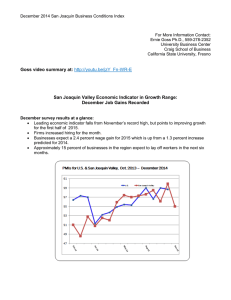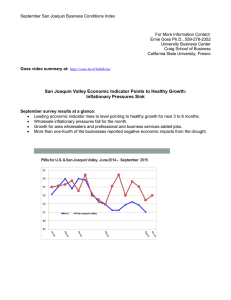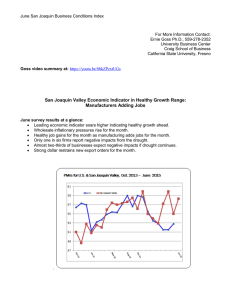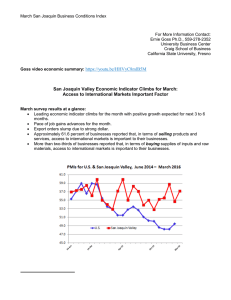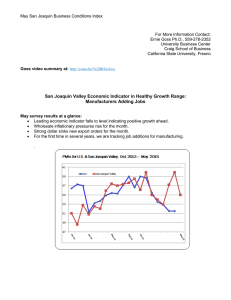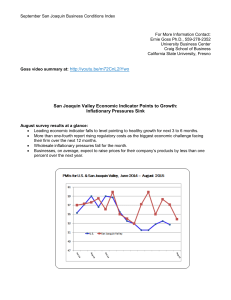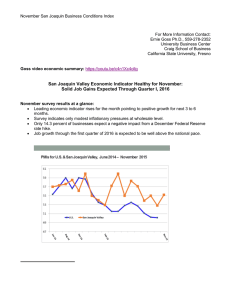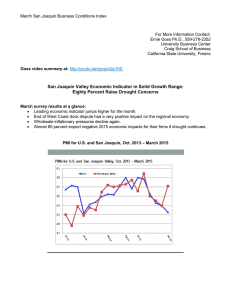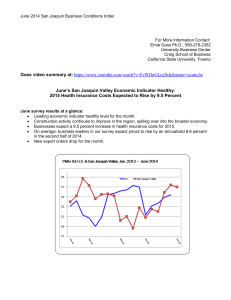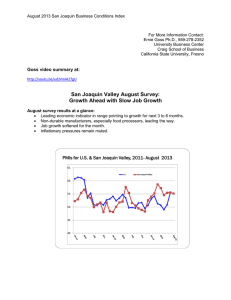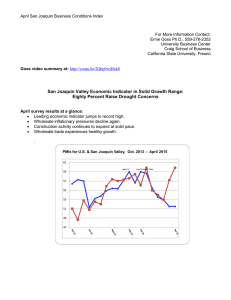Document 13092142
advertisement
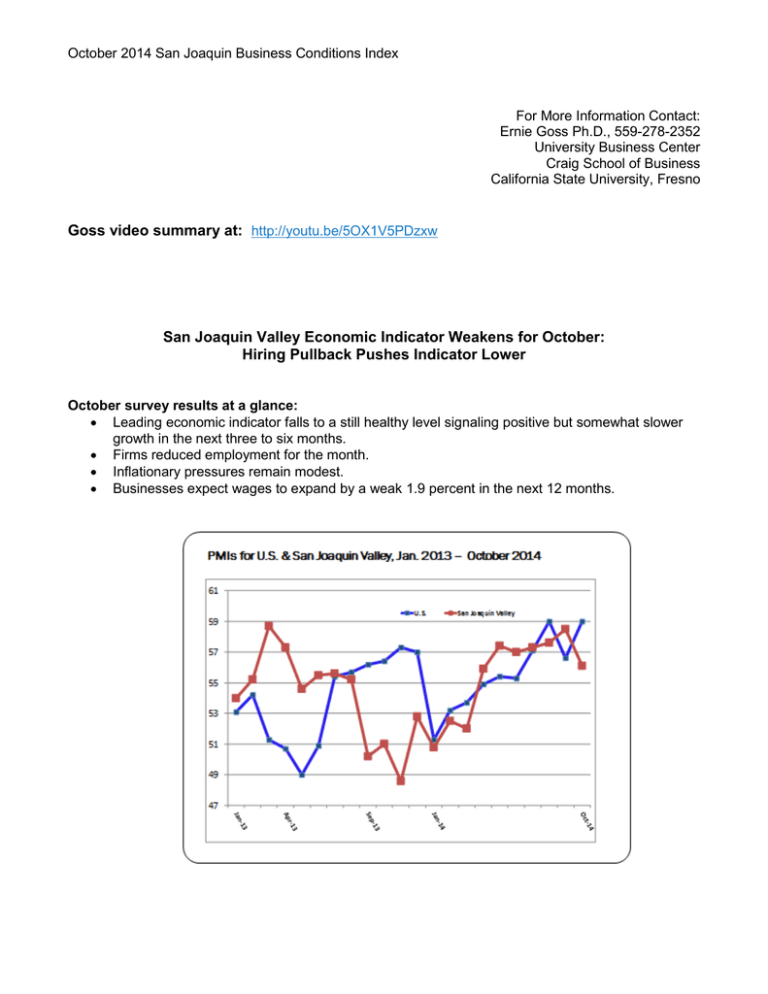
October 2014 San Joaquin Business Conditions Index For More Information Contact: Ernie Goss Ph.D., 559-278-2352 University Business Center Craig School of Business California State University, Fresno Goss video summary at: http://youtu.be/5OX1V5PDzxw San Joaquin Valley Economic Indicator Weakens for October: Hiring Pullback Pushes Indicator Lower October survey results at a glance: Leading economic indicator falls to a still healthy level signaling positive but somewhat slower growth in the next three to six months. Firms reduced employment for the month. Inflationary pressures remain modest. Businesses expect wages to expand by a weak 1.9 percent in the next 12 months. San Joaquin Business Conditions Index – p. 2 of 3 For Immediate Release: Nov. 3, 2014 FRESNO, CA-For the eleventh consecutive month, the San Joaquin Valley Business Conditions Index rose above the 50.0 growth neutral threshold. While the index is down for the month, the index, a leading economic indicator from a survey of individuals making company purchasing decisions for firms in the counties of Fresno, Madera, Kings and Tulare, remains at a healthy level points to positive and positive growth for the next 3 to 6 months. The index is produced using the same methodology as that of the national Institute for Supply Management (www.ism.ws). Overall Index: After increasing for three straight months, the index fell to a still healthy 56.1 from September’s 58.5. An index greater than 50 indicates an expansionary economy over the course of the next three to six months. Survey results for the last two months and one year ago are listed in the accompanying table. “Much like the national economy, the San Joaquin Valley economy is growing and, based on our survey results, expected to continue to grow in the next 3 to 6 months,” said Ernie Goss, Ph.D., research faculty with the Craig School of Business at California State University, Fresno. Employment: For the first time since January, the regional hiring gauge slumped below growth neutral. The regional job index slid to 49.3 from 54.9 in September. “There is currently a record number of workers employed in the region. Even so, employers in the region continue to expand output primarily by increasing hours worked of current workers and adding temporary workers. I think the October dip is temporary with hiring likely to move back to its positive trend in the months ahead, ” reported Goss. “This month we asked business leaders how much they expect wages and salaries for workers in their firm to advance in the next year. On average, growth of 1.9 percent is expected which is less than 2.2 percent growth experienced over the previous 12 months,” said Goss. Wholesale Prices: The prices-paid index, which tracks the cost of purchased raw materials and supplies, advanced to a level indicating only modest inflationary pressures at the wholesale level. The wholesale inflation gauge climbed to 60.9, up slightly from 59.4 in September. “Inflationary pressures at the wholesale level, according to our survey and other national surveys of businesses, are still in a range indicating only modest inflationary pressures,” said Goss. “This month managers and owners in the region how much they expect prices for raw materials and supplies purchased by their firm to grow in the next six months. On average, firms expect prices to expand by 1.5 percent, or 3.0 percent for the year. This is down significantly from March when we San Joaquin Business Conditions Index – p. 3 of 3 asked the same question. In March 2014, survey respondents expected a 7.0 percent gain over the next 12 months,” said Goss. Business Confidence: Looking ahead six months, economic optimism, captured by the business confidence index, declined to 53.5 from 57.1 in September. “A slowing global economy and global tensions offset optimism from an expanding regional and national economy,” said Goss. Inventories: Businesses increased inventories of raw materials and supplies for the month at a faster pace. The October inventory reading climbed to 54.1 from last month’s 51.5. Trade: The new export order index remained above growth neutral but did fall to 52.6 from September’s 55.1 while the import index dipped slightly to 52.2 from 52.4 in September. The stronger U.S. dollar, which makes U.S. goods less competitively priced abroad and foreign goods more attractively priced in the U.S., pushed new export order growth lower. “I expect the global economic slowdown and a stronger dollar to boost imports and restrain exports for the region in the months ahead,” reported Goss. Other components: Other components of the October Business Conditions Index were: new orders at 56.0, down from 68.7 in September; production or sales at 65.0, up from September’s 61.2; and delivery lead time at 56.3, up from 55.9 in September. Table 1 details survey results for October 2013, last month and October 2014. November survey results will be released on the first business day of next month, December 1. Table 1: Overall and component indices for last 2 months and one year ago (above 50.0 indicates expansion) San Joaquin Valley October 2013 September 2014 October 2014 Leading economic indicator 51.0 58.5 56.1 New orders 51.9 68.7 56.0 Production or sales 53.5 61.2 65.0 Employment 50.7 54.9 49.3 Inventories 40.4 51.5 54.1 Delivery lead time 58.6 55.9 56.3 Wholesale prices 57.6 59.4 60.9 Imports 42.9 48.9 52.2 Export orders 43.6 55.1 52.6 Business confidence 45.5 57.1 53.5 Craig School of Business: http://www.fresnostate.edu/craig/ubc/sjvs.html Follow Goss: Twitter at http://twitter.com/erniegoss or www.ernestgoss.com Blog: http://economictrends.blogspot.com
